Want to get started making costumes for figure skating, dance, etc? Here's some info on types of stretch fabric for performance costuming, and selecting the right spandex for your project.
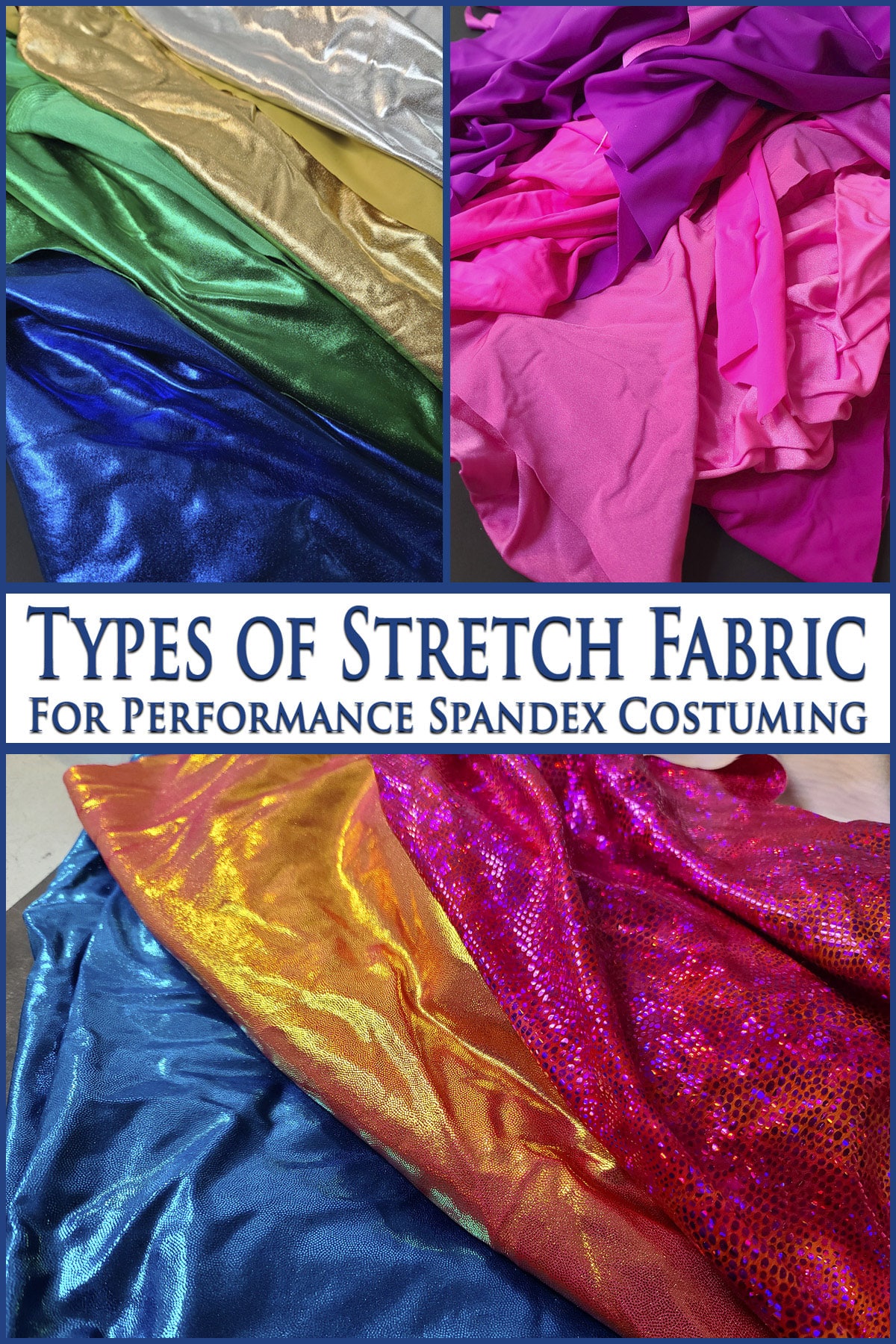
When starting off with sewing performance stretch fabrics, many people feel overwhelmed at the range of options, and the lack of information.
So, in an effort to help you with those decisions, here’s a big info dump on the subject of spandex.
First things first:
Spandex, Elastane, and Lycra® are all basically the same thing, with Lycra® being an actual brand name, “spandex” being the generic term in North America, and “elastane” being the generic term throughout the rest of the world.
I’ll be using them interchangeably in this post, to appease the Google overlords. 😉
Also: While this is a fairly comprehensive post when it comes to the basic options, there are ALL KINDS of offshoots from these, and a post to cover it all would be... a book.
I will try to cover the bases of the fabrics I use the most.
Two Way Stretch vs 4 Way Stretch
Spandex can be either 2 way stretch, meaning it will stretch along EITHER the length OR width, or 4 way stretch, meaning it will stretch along BOTH the length AND the width.
Pedantic note: “Warp” and “Weft” are how many people refer to a fabric’s length and width, but those are actually terms for woven fabrics! Spandex is a knit fabric.
In general:
4 way stretch tends to be a higher quality than 2 way stretch and is much more desirable to use in your projects.
4 way provides a much more comfortable fit, is less prone to ripped seams (assuming proper sewing technique!), and is definitely worth paying the extra money for.
2 way stretch fabric sometimes has a tendency to fray or pull, and is sometimes more sheer than the 4 way stretch.
4 way stretch fabric makes a more durable, comfortable garment base. I wouldn’t recommend using 2 way stretch fabrics for anything but applique designs.
Most performance costuming patterns - figure skating dresses, bodysuits, swimsuits, leotards, tights, etc - are designed under the assumption that you will be using 4 way stretch fabric.
Using a 2 way stretch spandex on a pattern designed for 4 way stretch won't fit right, won't move with the body the way the pattern intended, and won't be as durable, as a result.
Greatest Degree of Stretch
The “Greatest Degree of Stretch” refers to which direction of fabric has - wait for it - the greatest degree of stretch.
Sometimes the fabric will stretch more along the length of it - that is, parallel to the selvedge - selvage for the Americans! - the manufactured edge of the fabric.
Other times, the fabric will stretch more perpendicular to the selvedge, or along the width / cut end of the fabric, as it comes off the bolt.
The amount of stretch in either direction can vary wildly, as can the difference in degree of stretch.
In some spandex, you’ll find that one direction of stretch is great, and the other is so-so.
In others, it can be hard to figure out which is actually the greatest degree of stretch, as they both stretch fairly similarly.

As you can see, the greatest degree of stretch in this fabric - a good 4 way stretch spandex - is off by 1", on a ~5" piece!
Pattern Directionality
When selecting a printed spandex, you’ll want to check the directionality of the design, keeping in mind that the direction of greatest stretch has to go around the body.
Some printed fabrics will have a definite one-way design, or a linear design to it, whether that be stripes, banding, gradient, or whatever.
If there is, be sure that you will like the way the design looks with the greatest degree of stretch going across the body.
Do NOT try to swap the cutting directions, or the garment will not fit right, and/or could be quite uncomfortable even if it does end up “fitting”.
(Ie. Don’t try to cut a garment with the greatest degree of stretch going up and down, just because the pattern won’t look as good going across.)
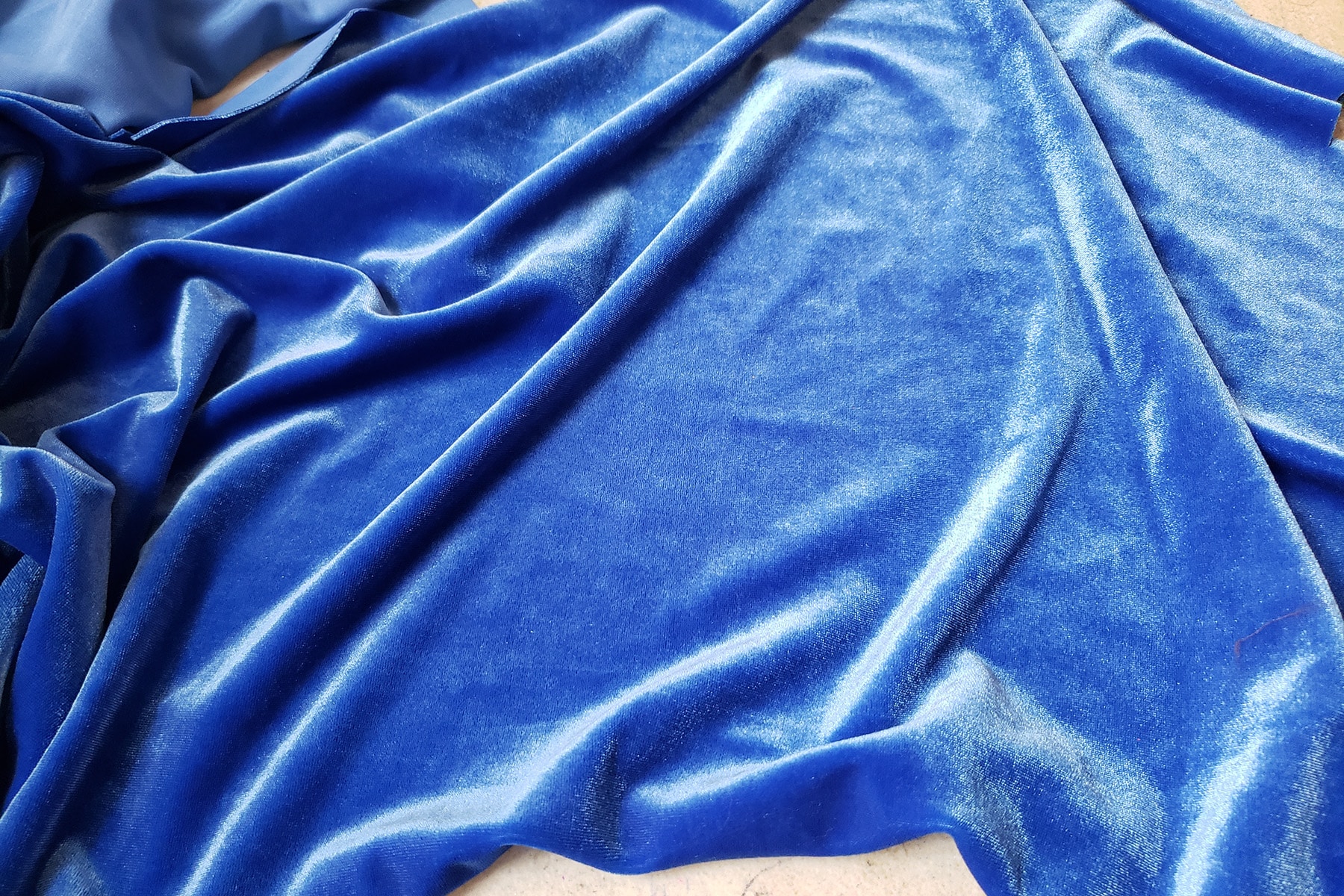
Velvet is gorgeous, but requires a bit of focus when cutting!
Nap
Printed fabric isn’t the only time you’ll need to keep an eye on directionality. For some - especially stretch velvets - you’ll need to be aware of the nap.
“Nap” refers to the directionality of the pile of a fabric - which way the fibres lay. When light hits the fibres, the fabric can look wildly different, if the fibres are pointing in different directions.
I’ve seen velvets that look like completely different colours, depending on which direction the nap is facing.
When cutting your pattern out of a fabric with nap, it’s EXTRA important to lay your pattern pieces all facing the same way, as nap effects the way a fabric looks, when worn.
That is to say, if you cut out a bodice where the nap faces one way on the front, and the other way on the back, they will likely end up looking like 2 different fabrics.
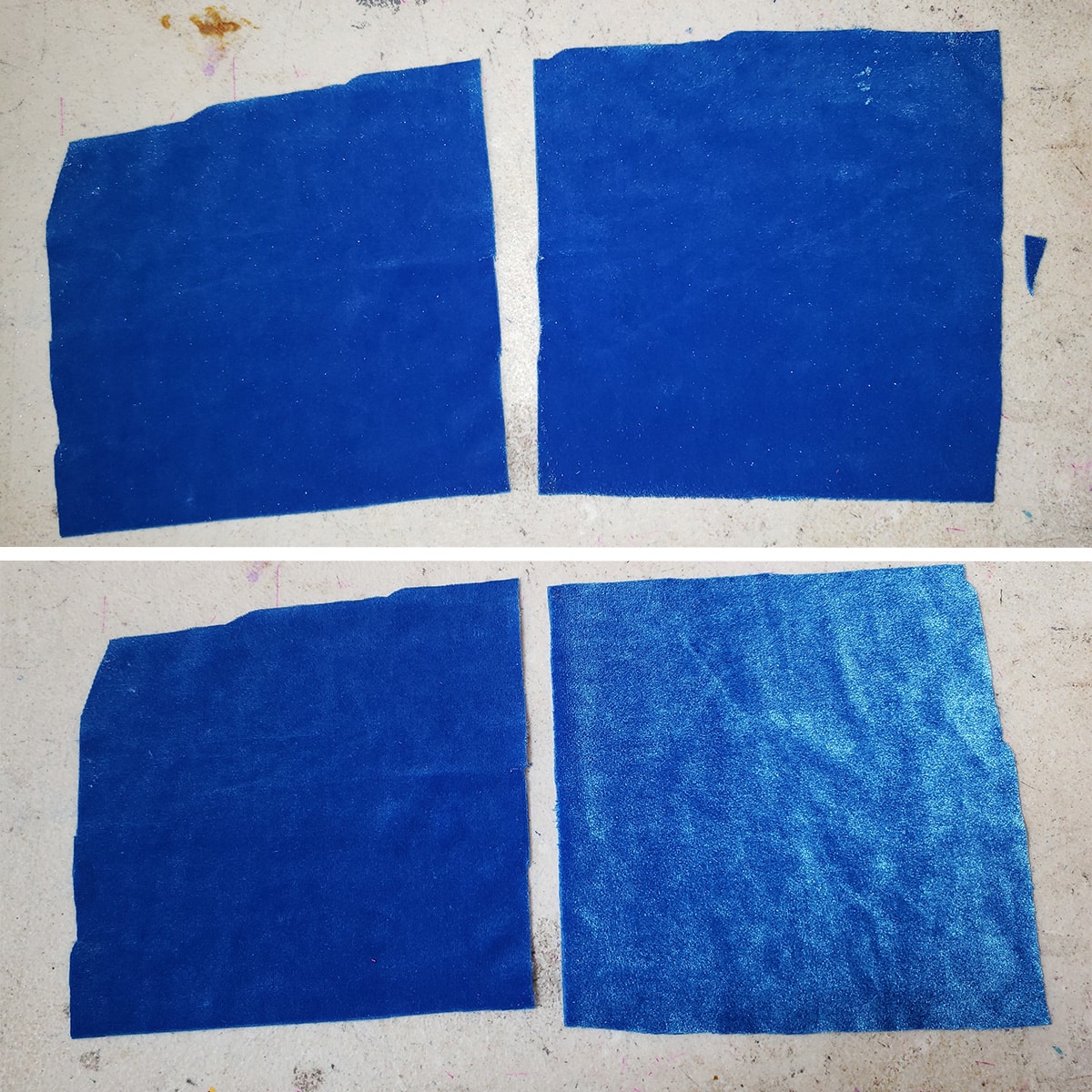
The top two pieces are facing the same direction. In the bottom two, one has been rotated.
Another Example:
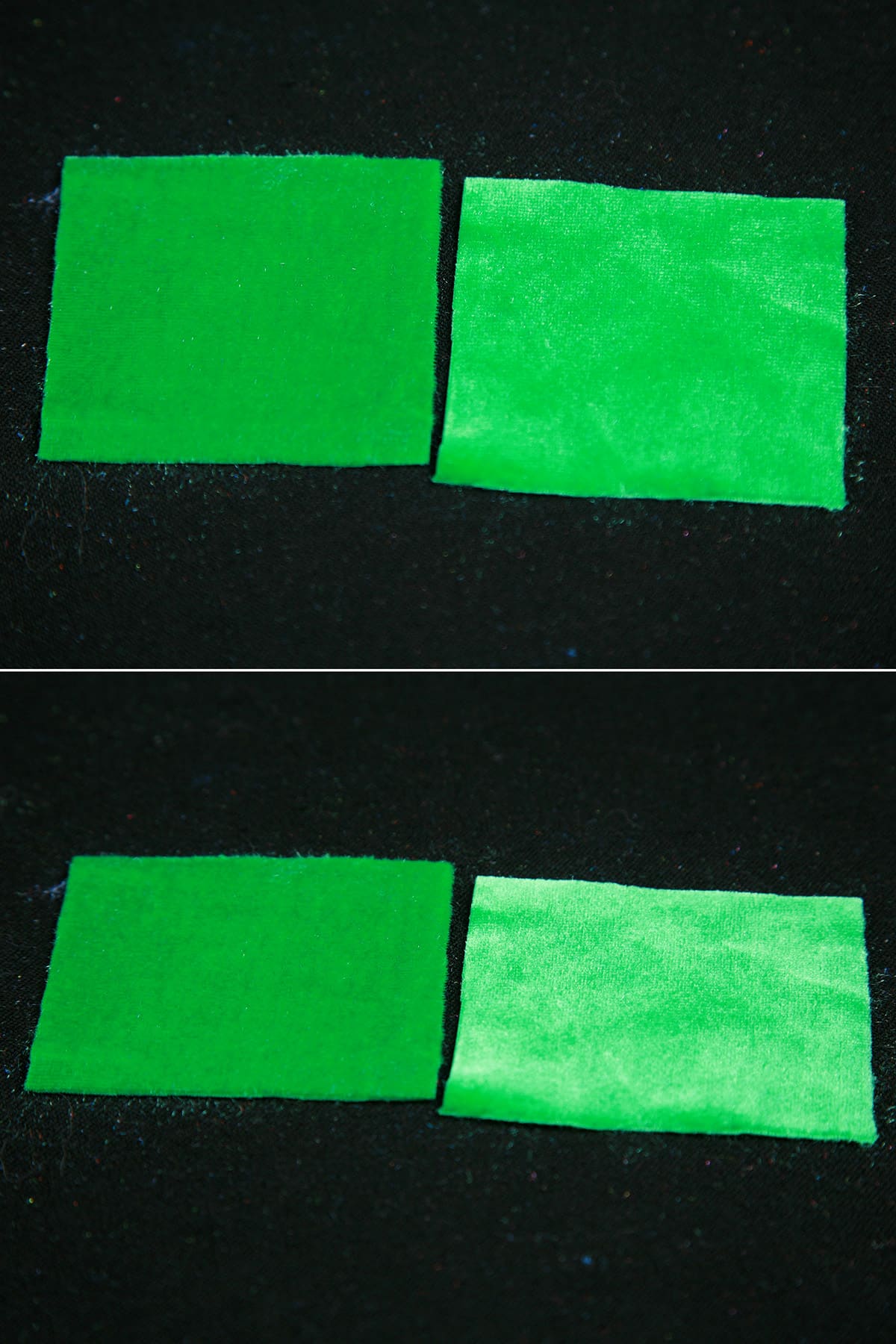
These two pieces are the same fabric, but one has been rotated to show the difference nap can make.
Note: It can be hard to see the difference when up close, but don’t let that fool you into making a mistake. The difference can be STRIKING when the garment is actually worn!
To prevent this, just ensure that the “up” side of all your pieces (ie: shoulders of bodice/sleeve pieces, the waist of a panty piece or tights - all face the same direction when you’re laying it out.
As a note: When it comes to velvets, I tend to prefer to cut them so that the nap smooths *downward* on the body, for a sleeker look.
If you’re looking for more visual texture, you can do the opposite.
Quality of Fabric
Another thing to keep in mind about purchasing fabric is the actual quality of the fabric.
If you pull on an edge, and see little white elastic fibres, it’s a cheap fabric, and isn’t very durable.
Also, see if it goes see-through when you stretch it.
Fabric like this has a tendency to wear down a lot faster than not.
Spend the few extra dollars buying decent fabric up front, instead of spending more time and money a few months down the line to re-do it.
As a general rule of thumb, the spandex you buy from spandex-specific shops is going to be better (and more reasonably priced!) than spandex you find in generic fabric shops and chains.
Anyway, let’s look at some of the main types of fabric you’ll come across in Spandex costuming.
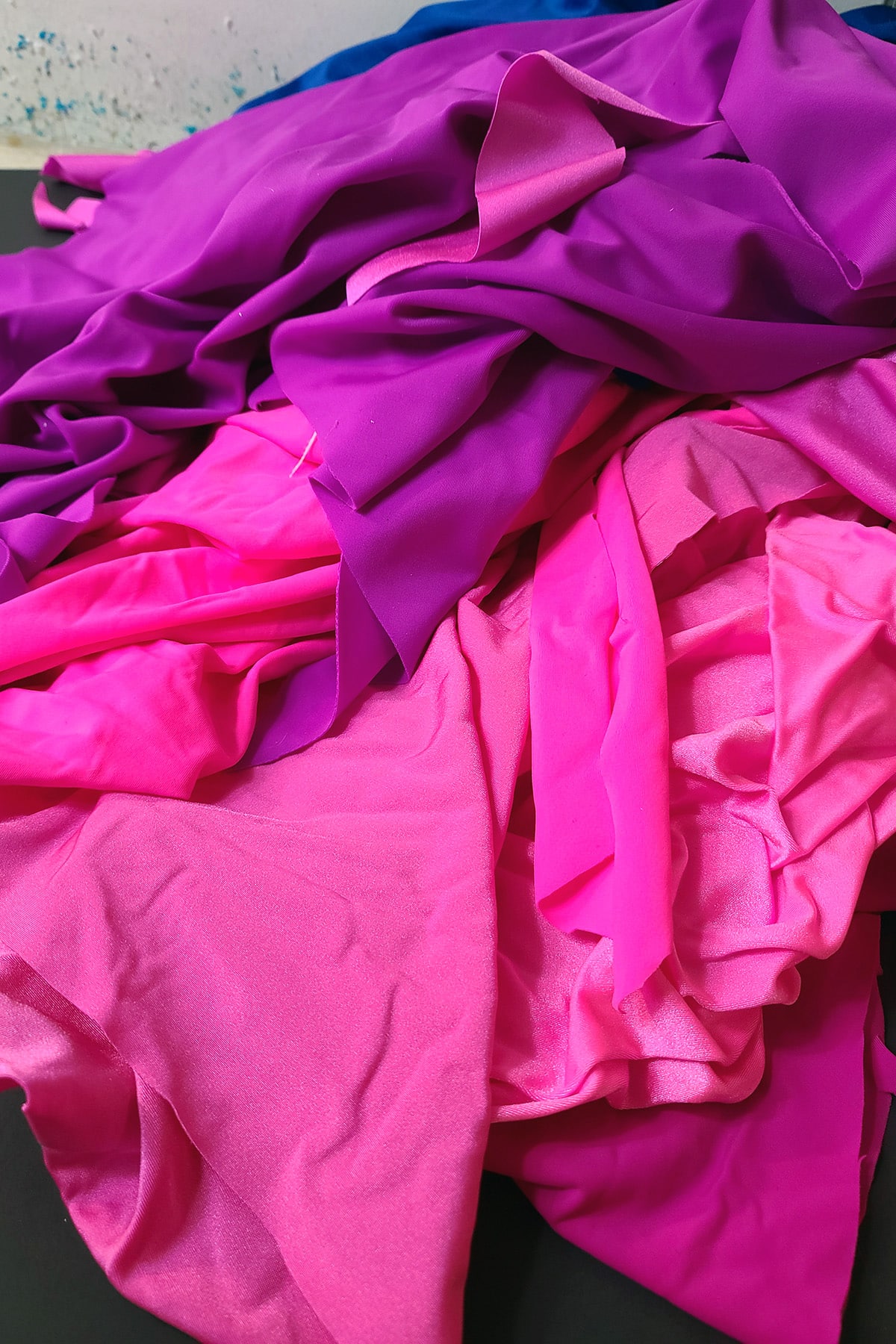
Nylon Lycra®
The Solids
Nylon Lycra®
Basic nylon spandex comes in varying qualities, prices, colours, weights and textures.
It’s usually sold as one of three finishes:
“Shiny” - This is the basic finish that you see on a lot of gym sets, swimsuits, etc. Not “shiny” in a metallic sense, just ... not matte.
“Matte” - A flat, not-shiny finish.
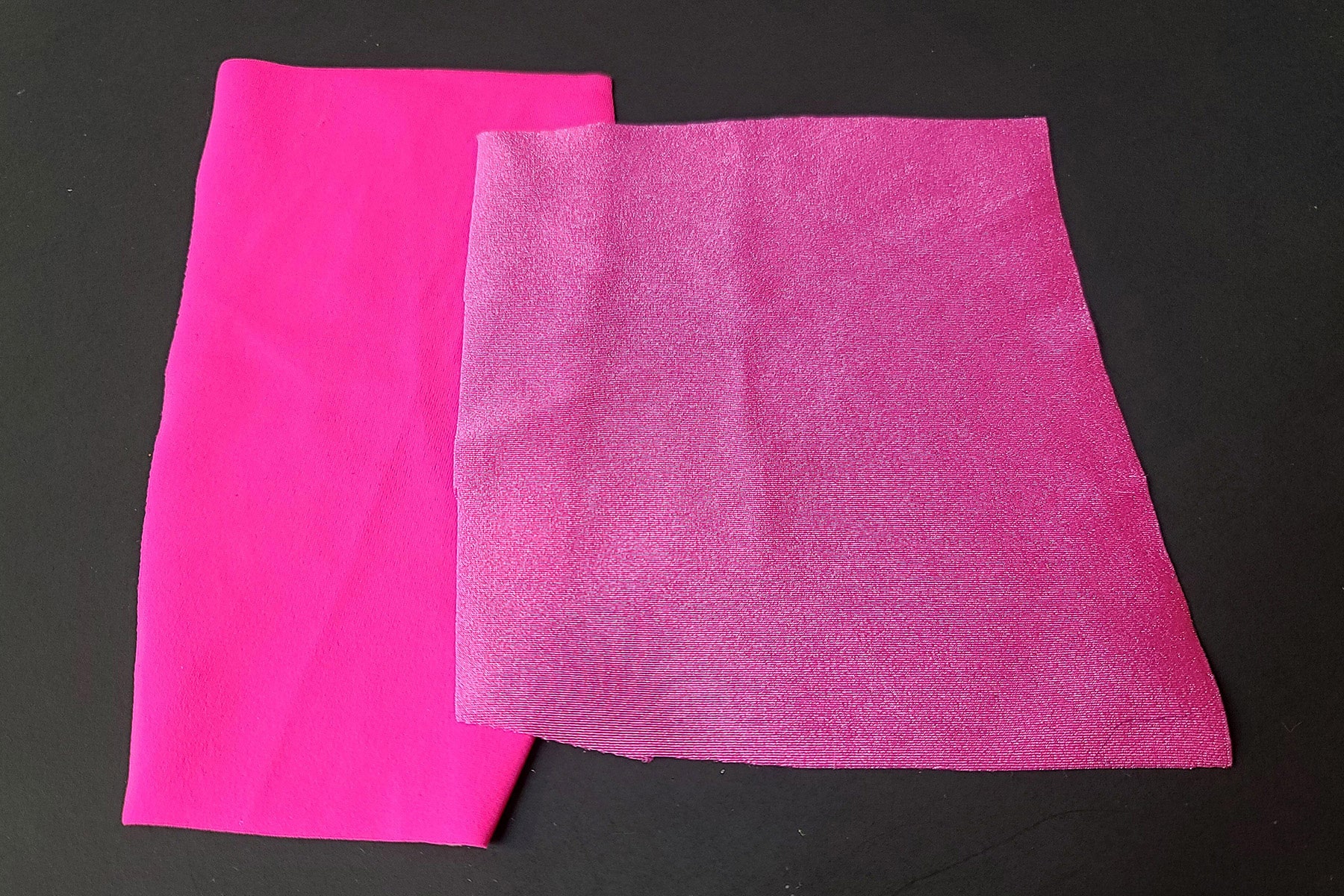
Matte (left) vs Shiny (right) Nylon Lycra®
“Wet Look” - this goes a step beyond “shiny”, with a thin, plasticy type finish on the good side of the fabric. Note that it’s not a separate LAYER of a plastic - wet look spandex is not the same as stretch PVC.

Wet Look
Here are a few more comparison images:
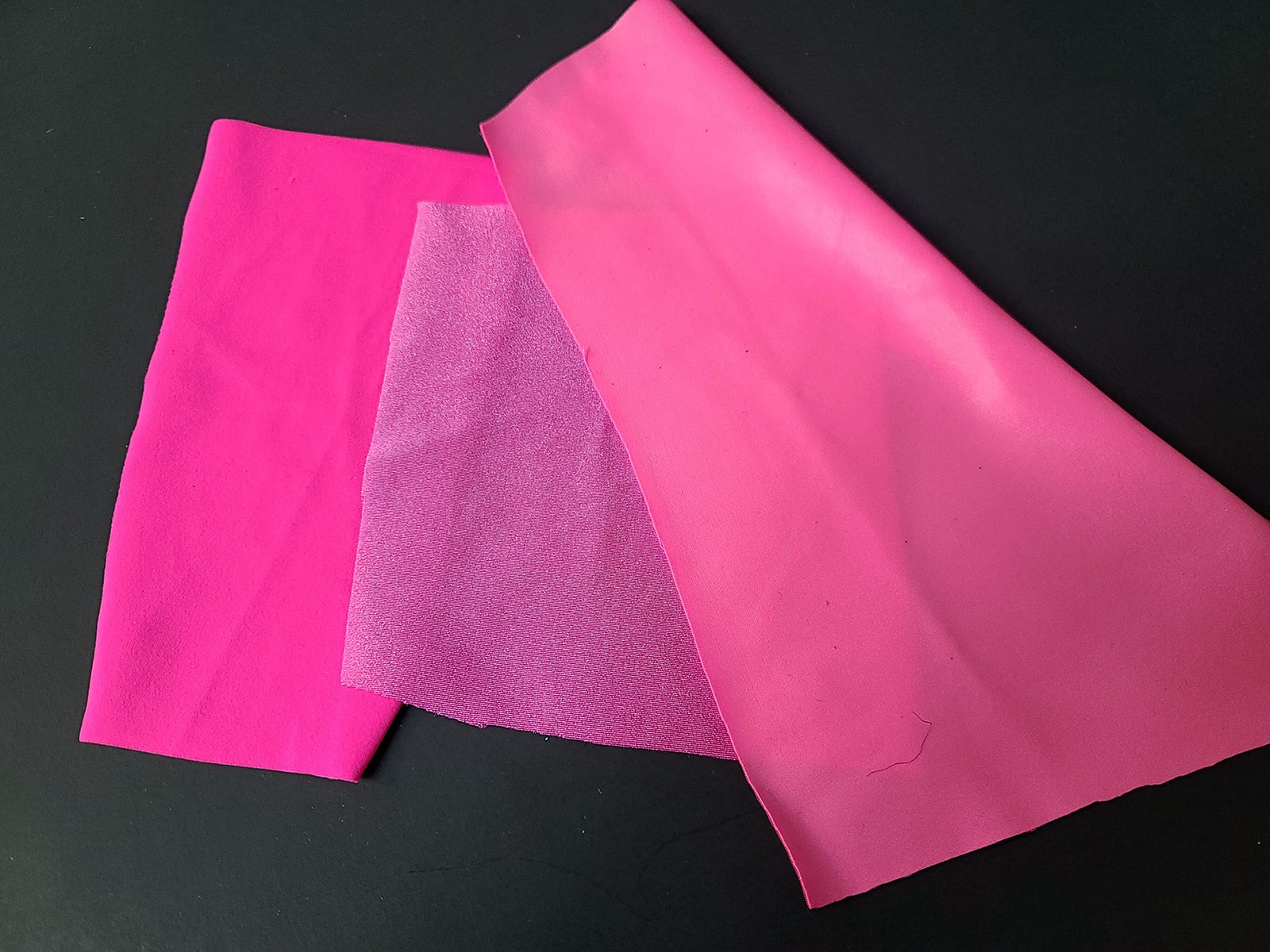
L-R: Matte, Shiny, and Wet Look.

Shiny (top) and matte (bottom) nylon spandex.
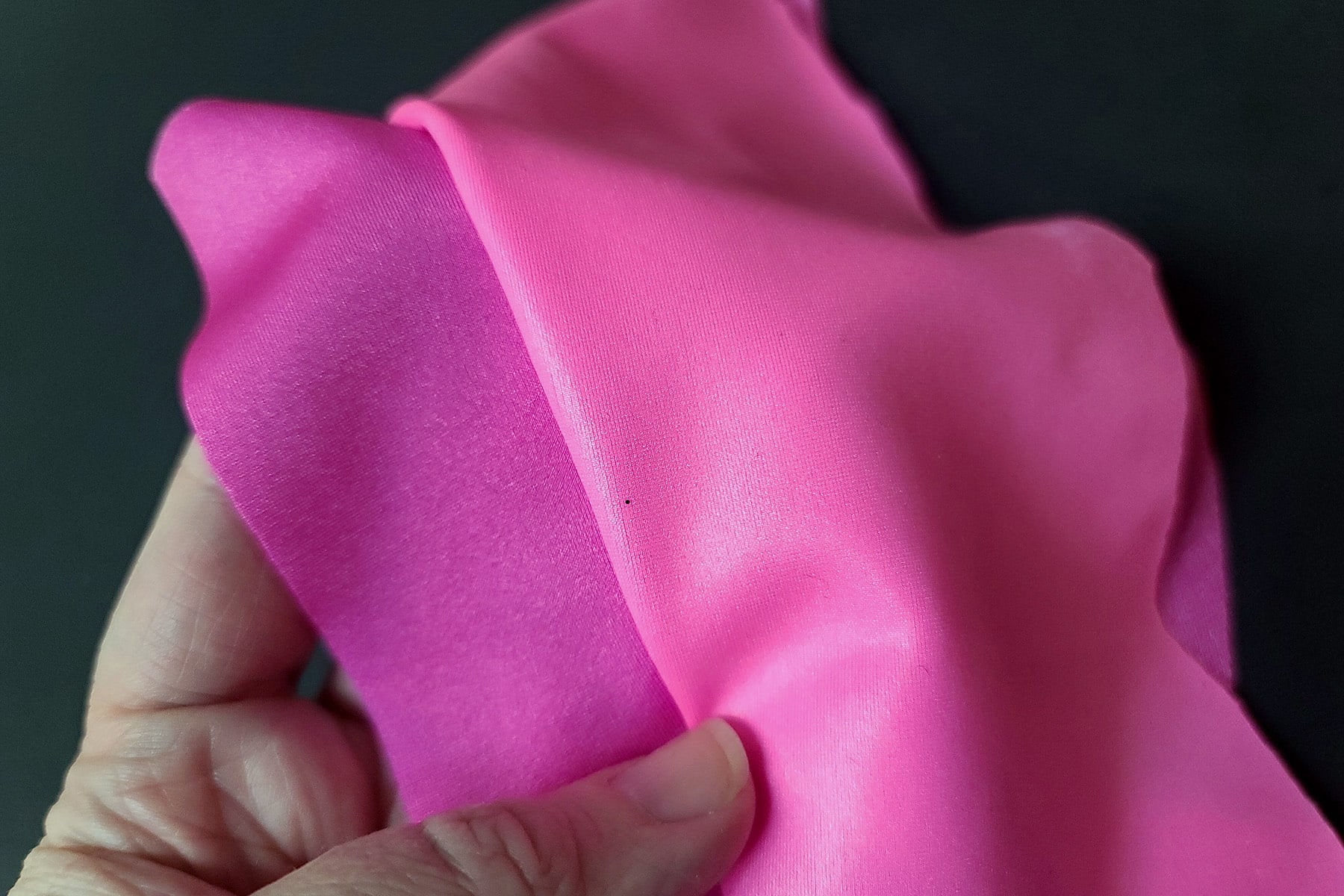
Shiny (left) vs Wet Look nylon Lycra® (right).
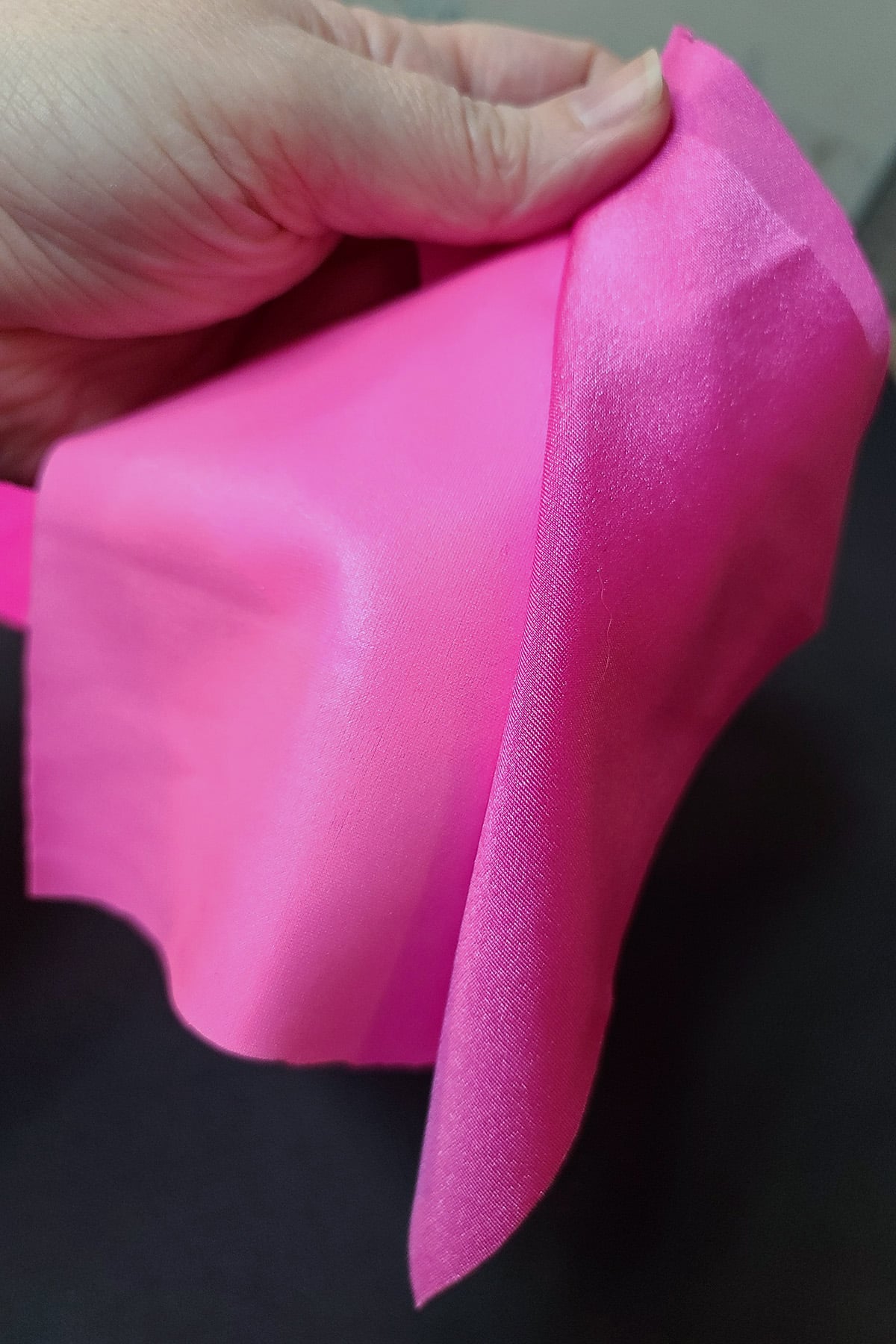
Wet Look (left) vs Shiny (right) Nylon spandex
It can be plain, printed, pebbled, “waffle weave” look...
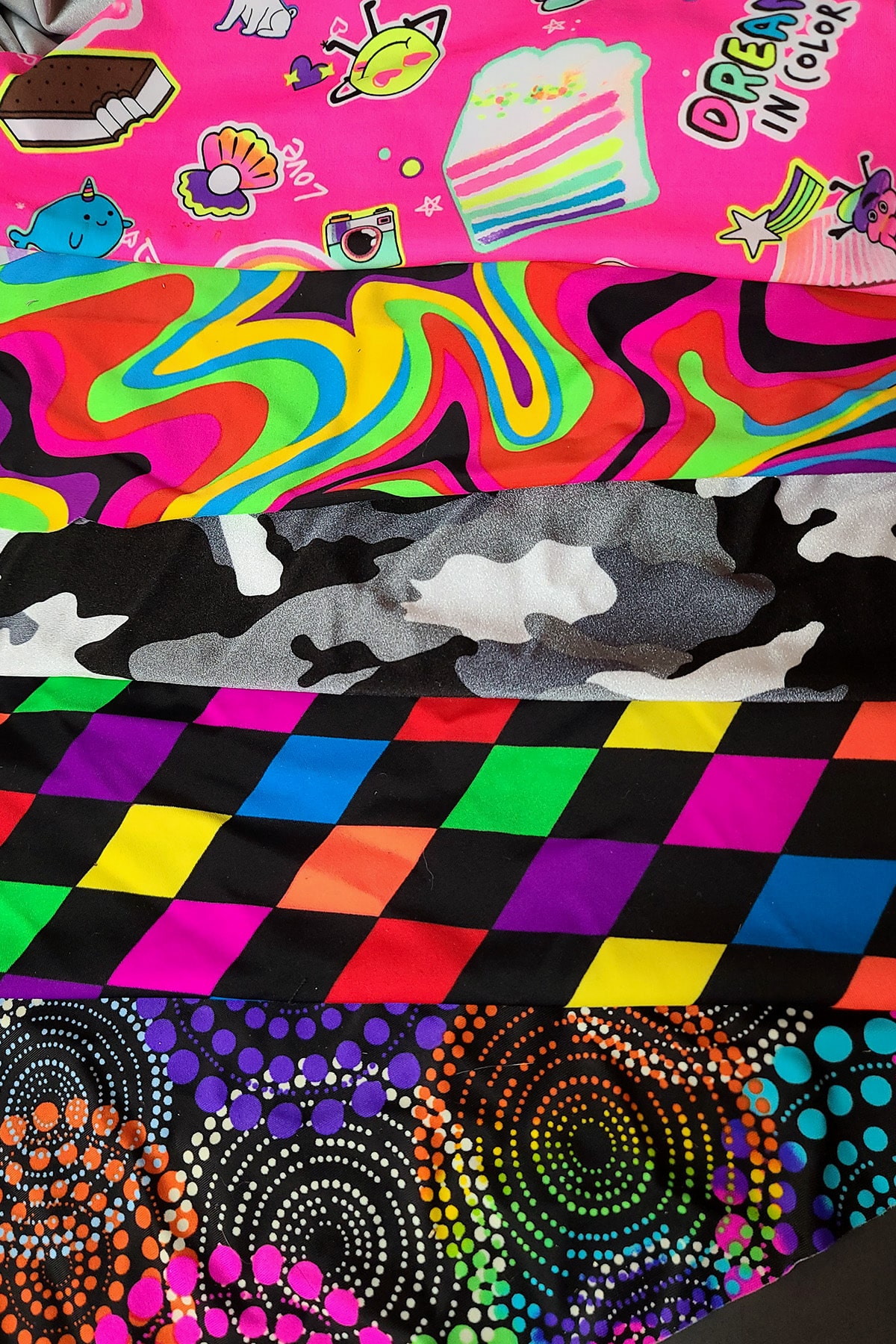
Printed Nylon Lycra® (The brighter and tackier, the better IMHO!)
... or even embellished with a bit of glitter accent, as in the blue fabric swatch below:

Glitter Print Nylon Spandex
You can find this spandex sold as milliskin, nylon Lycra®, tricot, and under other brand names.
I tend to like it best at 80-85% Nylon, 15-20% Lycra®/spandex.

Moleskin / Heavyweight Spandex
Moleskin Spandex
This is a heavy 4-way stretch spandex. It looks basically the same as basic nylon Lycra®, with a few differences.
Moleskin Spandex is heavier, and comes in a limited number of colours. It usually has a decent amount of stress in one direction, and more of a “meh” amount in the other direction.
When the available colours work for what you want to make, this is a great base fabric for men’s skating pants, superhero cosplay, and wrestling costumes.
It’s a fair amount more durable than basic spandex. “Jumbo Spandex” is another heavyweight option.
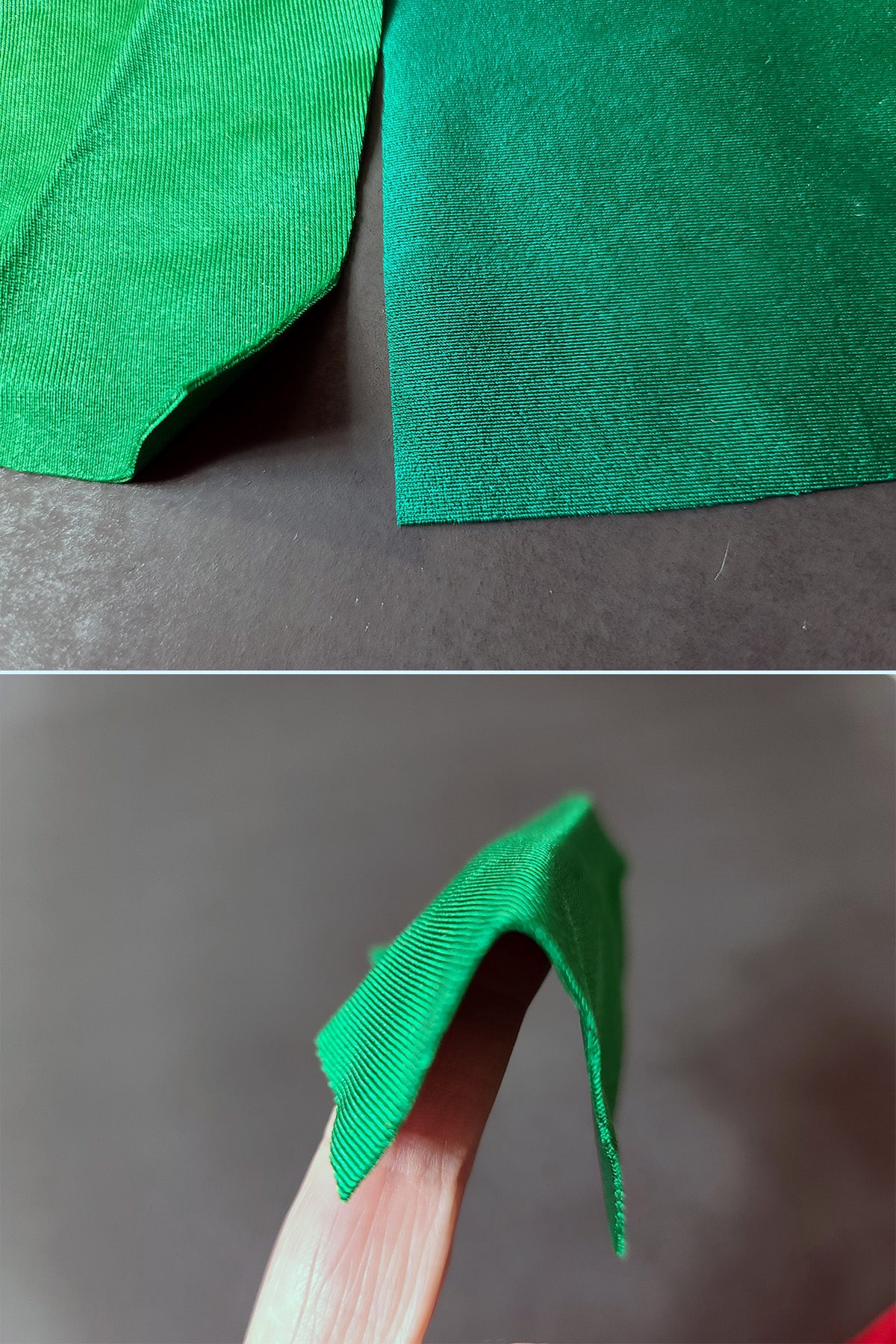
Moleskin (Left) vs Tricot (Right), moleskin draped.
Stretch Poly / Polyester Lycra®
Poly is generally thinner, lighter weight, and smoother than nylon Lycra®.
I usually see it as digital print stretch fabrics - this is when a design is printed onto one side of the fabric, rather than injected / dyed right through.
Due to the nature of this dyeing technique, the underlying spandex -usually white - tends to show when the fabric is stretched.
As such, I find it less than ideal for the structural parts of a stretch garment, and will generally only use it for sections that aren’t subjected to a lot of stretching, such as a skirt or pouf sleeve.
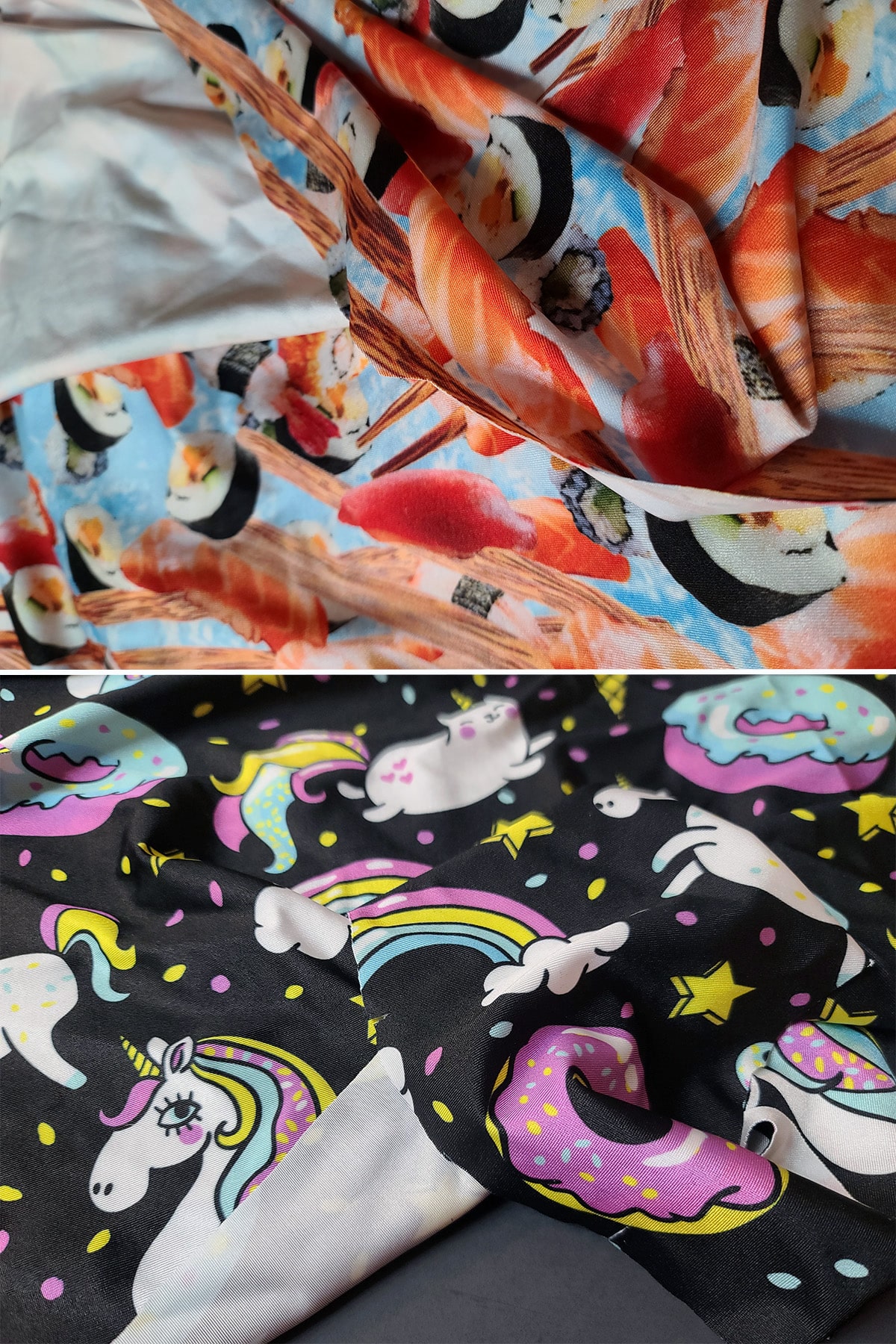
Poly Spandex
Cotton Lycra®
As with nylon Spandex, cotton Spandex comes in varying colours, qualities, and weights.
Cotton Spandex is most suitable for shorts, sports bras, and garments of that nature - not as much for superhero costumes or much of anything used in a competition.
Also, I personally wouldn’t recommend cotton Spandex for a swimsuit. Cotton spandex loses some if its “recover” ability when it’s wet.
It can stretch, and not snap back to its original shape of size, which can lead to sagging. No one wants a saggy bum on their swimsuit!

Cotton Lycra®
Peachskin / Brushed Poly
This is a soft, cottony-finished spandex that is super popular for leggings.
If you’ve ever worn leggings from an MLM company and/or that were marketed for how “buttery soft” they are, you’ve handled peach skin / brushed poly / double brushed poly.

Brushed Poly Fabric
Hologram / Metallic Spandex
Hologram spandex is a plain nylon spandex with reflective bits of foiling fused onto it into various patterns - star bursts, snake skin print, or geometric tessellations.

Hologram Spandex
Hologram Spandex is usually fairly expensive, ranging from $20 - $40 per metre for quality. It comes in ALL kinds of colours - both base colour and the metallic print embossed on it.
It also comes in a ton of different patterns, which can sometimes be used as the name for the type of spandex.
Cracked Ice, Holo Mini Dot / Microdot (often called “Mystique”, more on that in a minute!), Mirror Dot, Shattered Glass, and Mermaid are all varieties of hologram prints, and there are MANY more beyond that.
You can even find holographic spandex where the base fabric has been ombre dyed or tie dyed.
Although this fabric is very cool, and you may be tempted to make an entire outfit of it, be forewarned - this stuff can really be a case of “too much of a good thing”.

Hologram Spandex
Note: when the metallic dots are extremely small and close together, the fabric usually goes by the name “Mystique”. Mystique comes in a bunch of colours, including a few pearlized finish versions.
One thing to keep in mind: Mystique is an actual brand name, but the word ALSO gets used as a generic term for fabrics of that style - much like “Velcro” has come to refer to hook and loop tape, regardless of brand.
If you’re looking for the actual, brand name Mystique, be sure to check the selvedge for the trademark!
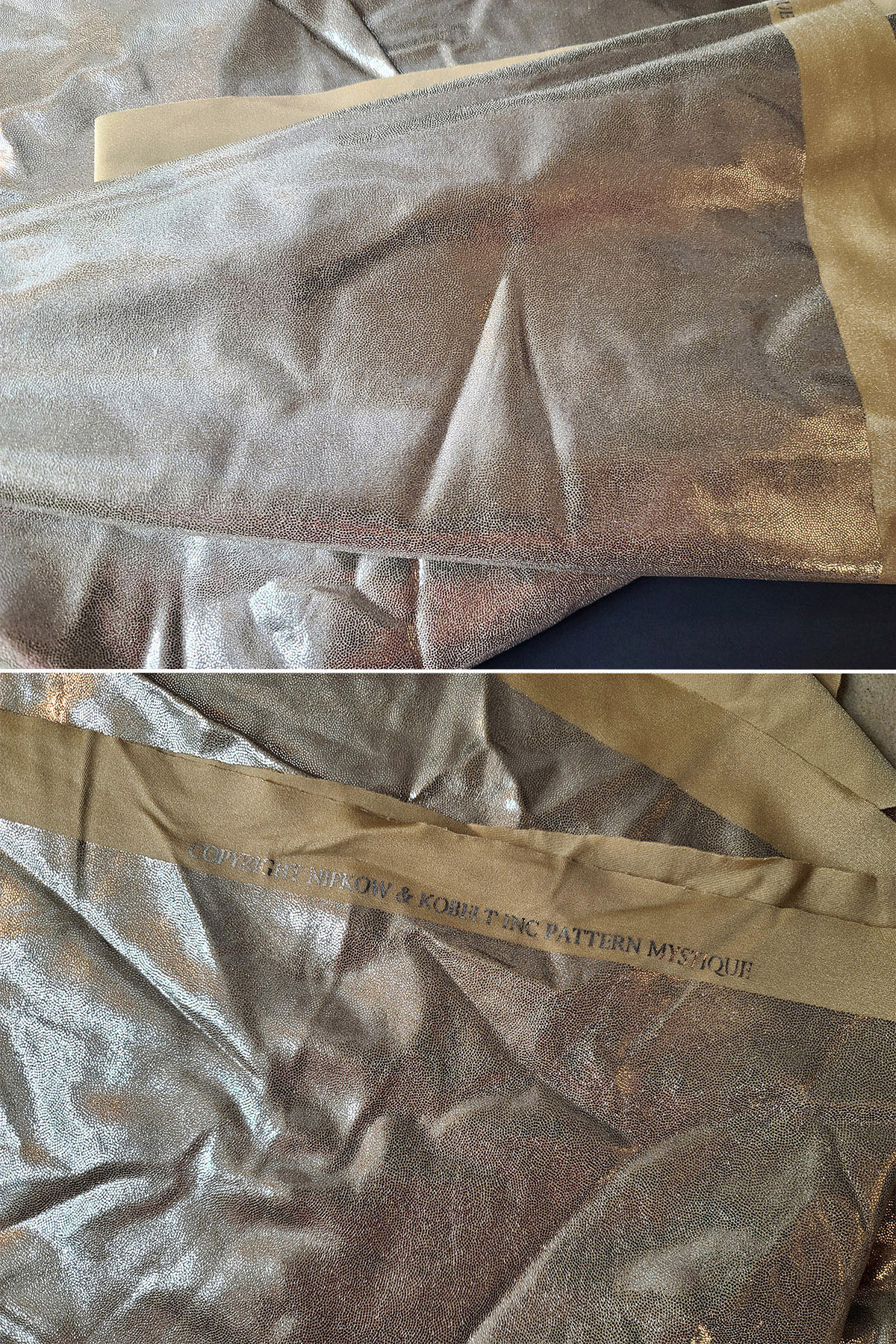
Actual Brand Name Mystique
Metallic / Foil Spandex
Metallic Spandex started out mostly in gold and silver, but was soon available in many colours . I’ve also seen this fabric referred to as “liquid gold” “liquid metal”, and “liquid silver”, but that can get confusing with the non-spandex fabric of the same name.
This is a really high quality spandex with 4 way stretch, great recover ability, and is easy to sew with.
The metallic effect is non- holographical, just a smooth, solid effect of metal.
Metallic Spandex can be tricky to buy, as there are many cheap stretch fabrics out there, with the same sort of look.
The rule of thumb I’ve found: if the metallic finish is printed on to a coordinating colour spandex, it’s probably the good, 4 way stretch fabric.

Foil / Metallic Spandex
This is far more durable than the cheaper version, which is usually printed on a thin white spandex. You don’t want the cheaper stuff - the foil rubs off quickly, leaving an almost sheer base.
The fun thing with metallic spandex / foil Lycra® is that it really highlights the physique.
It’ll cling to every curve, and produces a sort of highlighting / shadowing effect when it comes to muscles.
This can be a really cool effect when it comes to superhero or fitness costuming!

Foil / Metallic Spandex
Foil Print Spandex
This fabric is plain or printed Spandex, with accents of foil embossed on it. (Not a solid foil)
Usually mostly available through mail order - in in spandex specialty stores - foil spandex is a little expensive, and doesn’t always have the best stretch both ways - it’s usually more of a 2 way stretch fabric.
Faults aside, foil print spandex has a very nice effect when light shines on it.

Stretch Velvet
Spandex - Backed / Stretch Velvet:
This is not to be confused with Panne velvet -which is no good for our purposes.
Stretch Velvet tends to cost much more than Panne, usually around $20-$40 ish per metre, as opposed to around $10 per metre.
Spandex backed velvet should have a 4 way stretch, and usually comes in either flat / plain, “crushed” varieties:
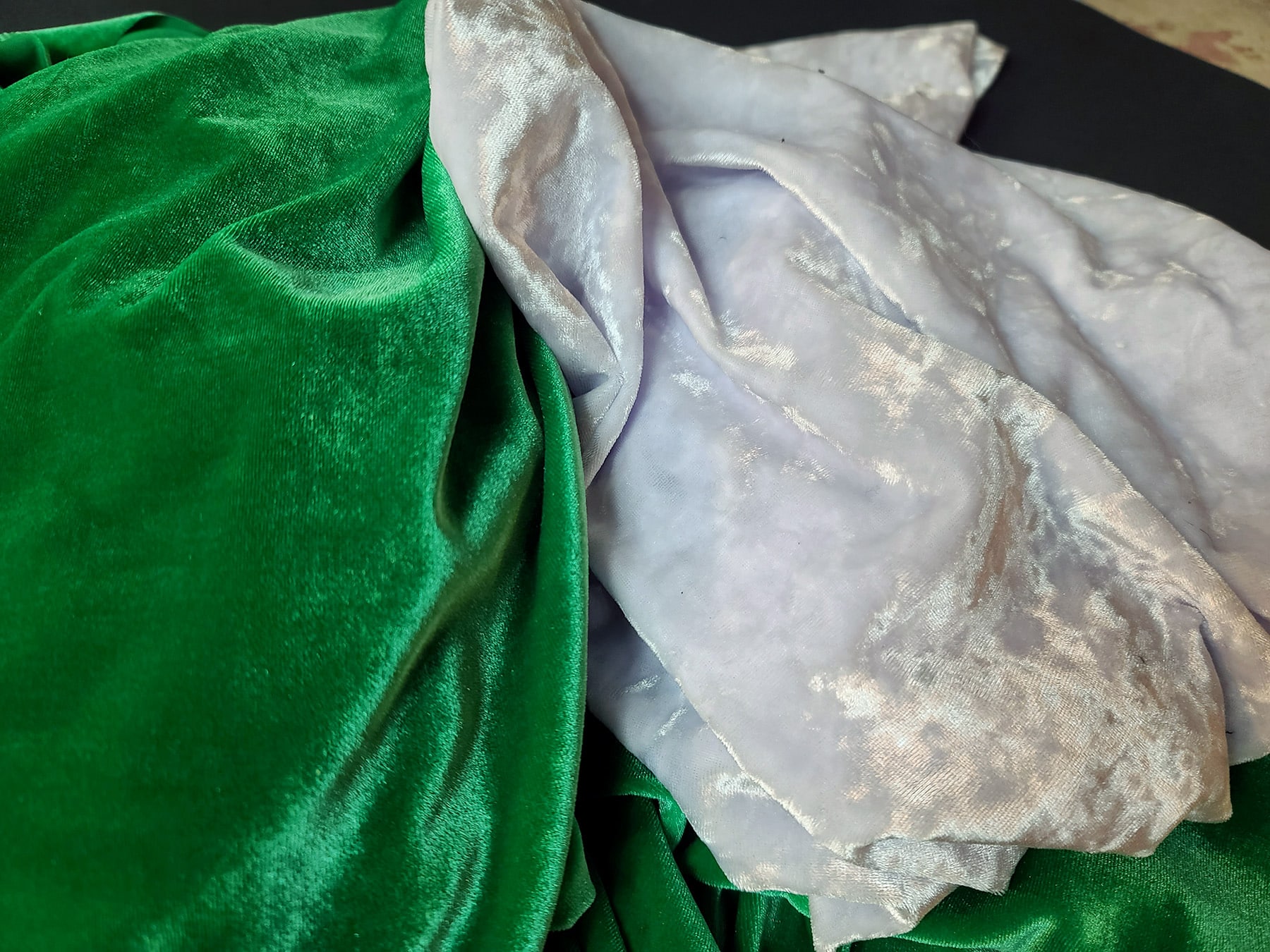
"Flat" spandex backed velvet (left) vs crushed (right)
... and sometimes you can even find it in novelty textures, like this:
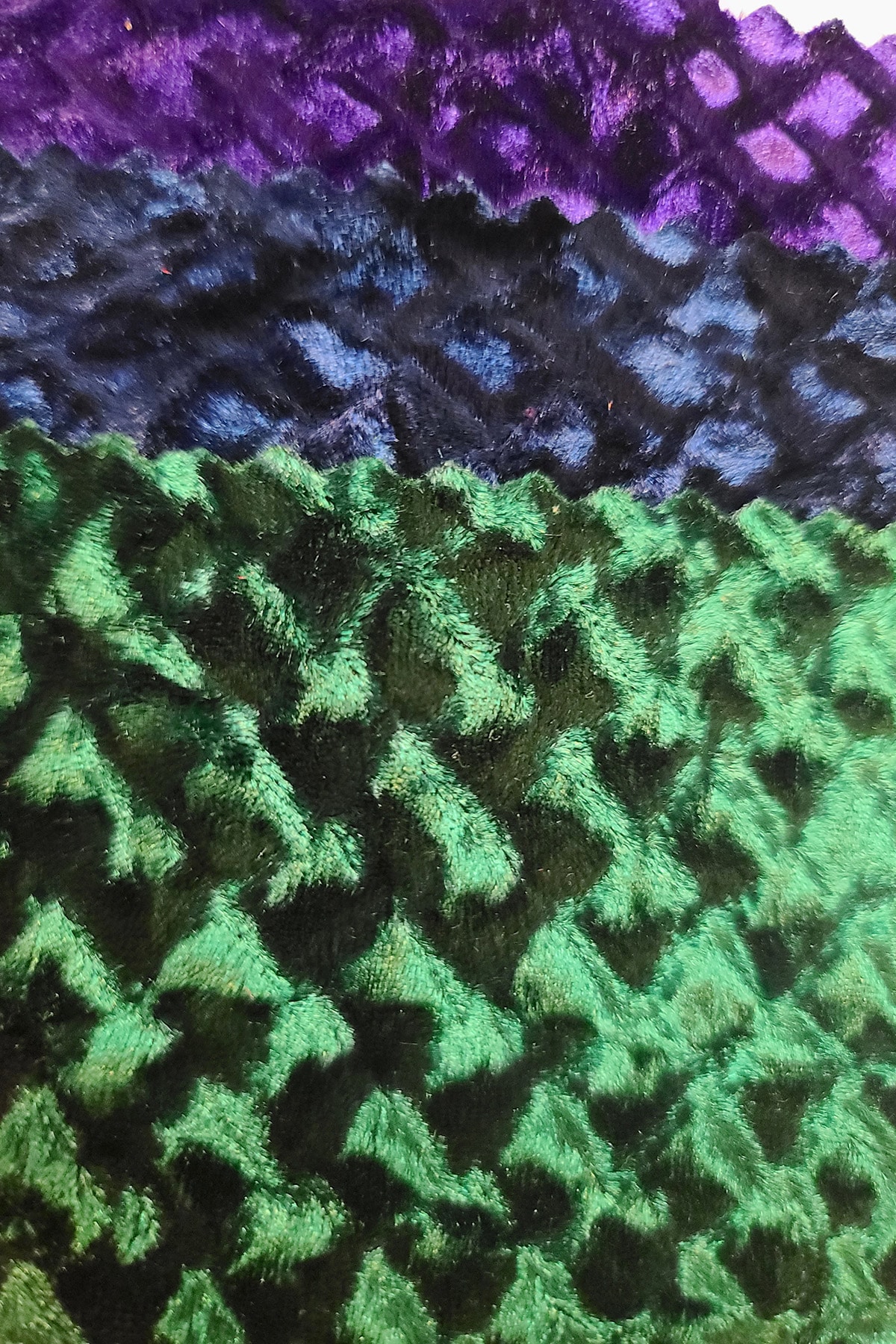
Textured Stretch Velvet
Additionally, some varieties have glittery designs embellished right onto them.
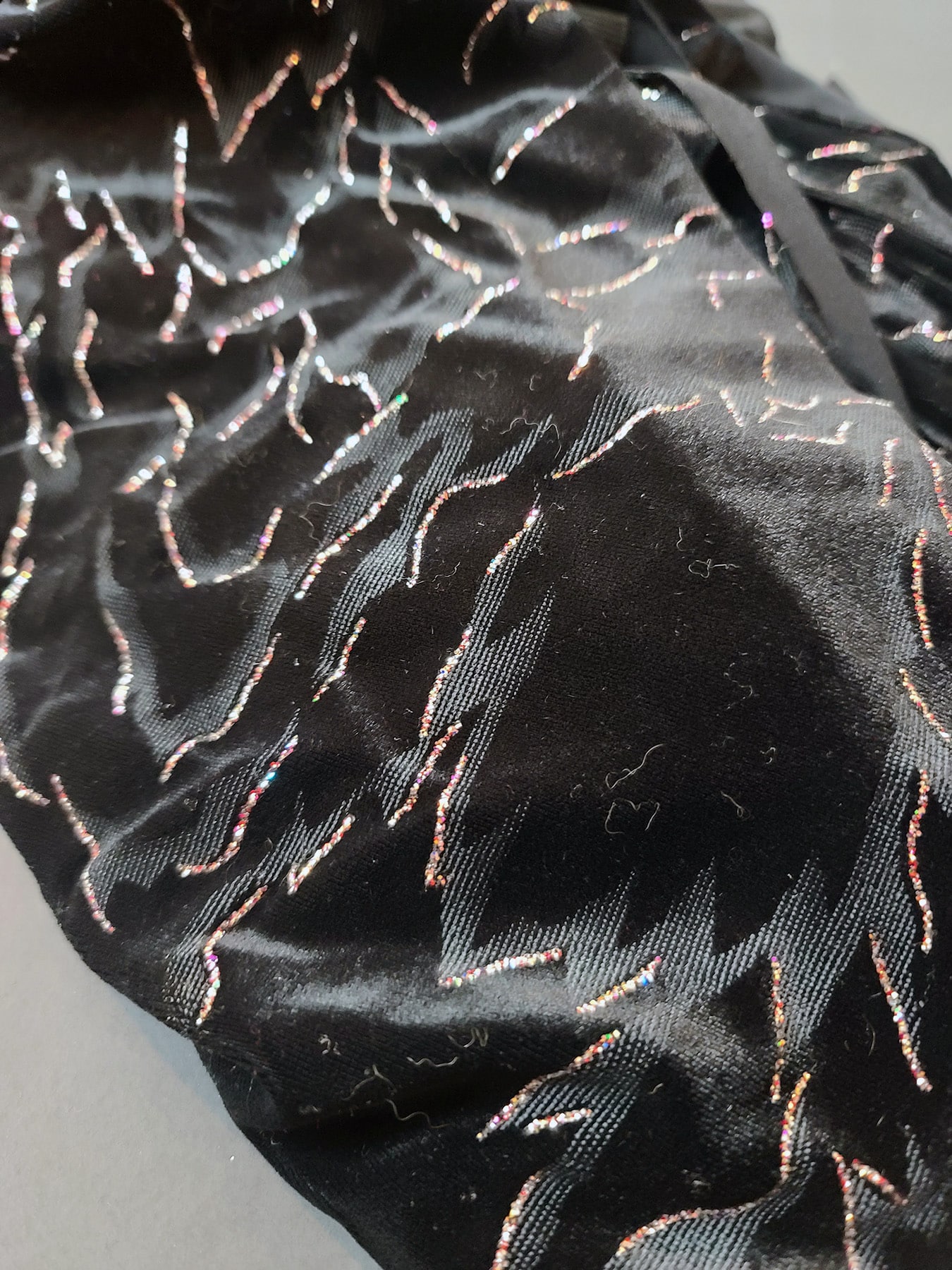
Glitter Print Stretch Velvet
While nomenclature can vary from brand to brand and retailer to retailer, I tend to differentiate:
Shimmer Velvet: Has an all over, evenly spaced, subtle glitter.
Glitter Velvet / Sparkle Velvet: Has heavier lines of glitter design.
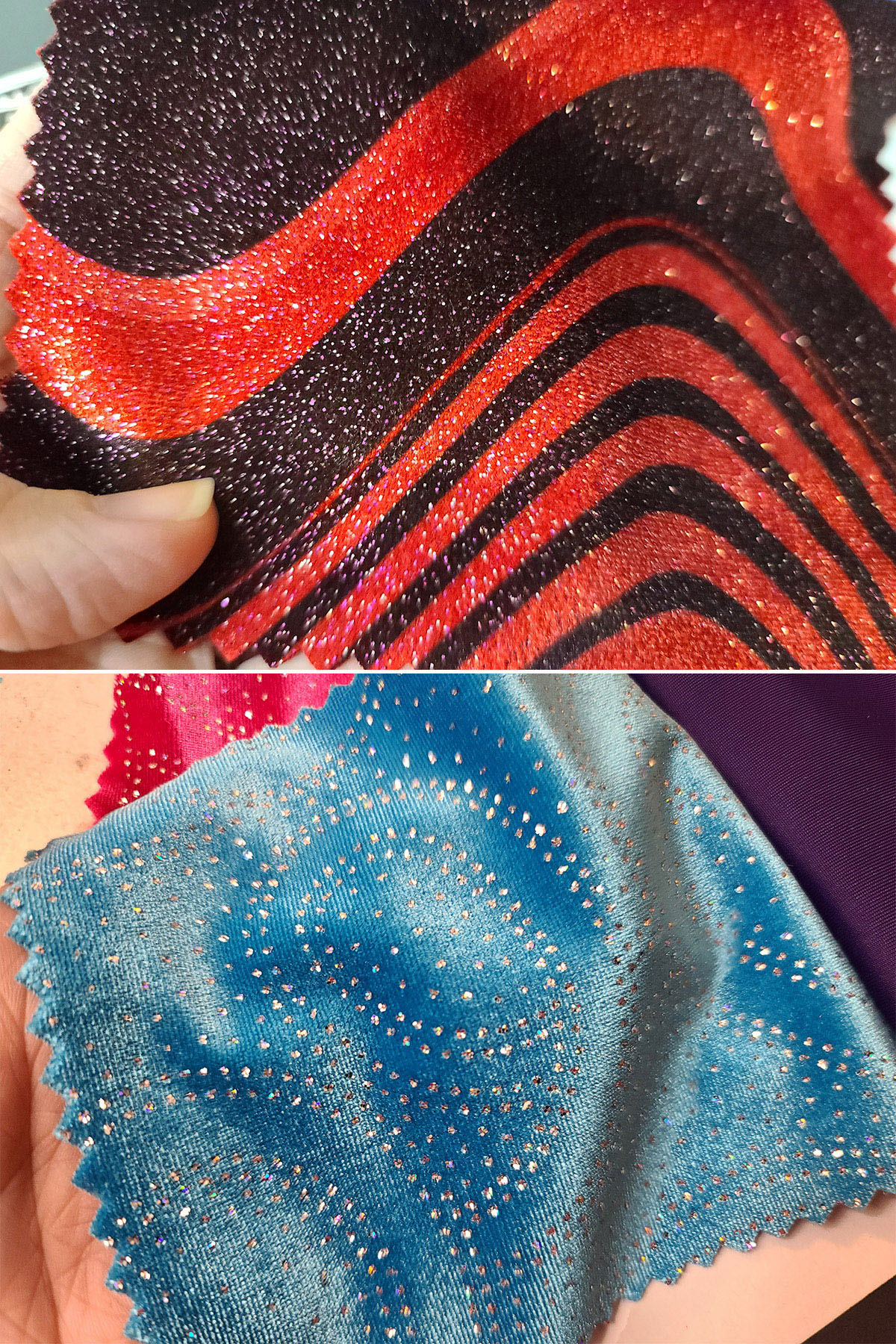
Shimmer Velvet (top) and Glitter Velvet (Bottom)
Panne Velvet
In contrast to good stretch velvet, panne velvet tends to default as a crushed, textured appearance, and is rather cheap.

Crushed Stretch Velvet (left) vs Panne Velvet (right)
It is only a 2 way stretch fabric, is NOT on a spandex base, and isn’t really suited for spandex costuming, unless used for pieces which do not require much stretch (say a structured push-up type bikini bra top, skirts, sleeve inserts, etc.)
While it’s OK (JUST “ok”!) for those kind of accents ... I’d suggest just steering clear of it, entirely. I’m only including the information here as a “what NOT to use”!
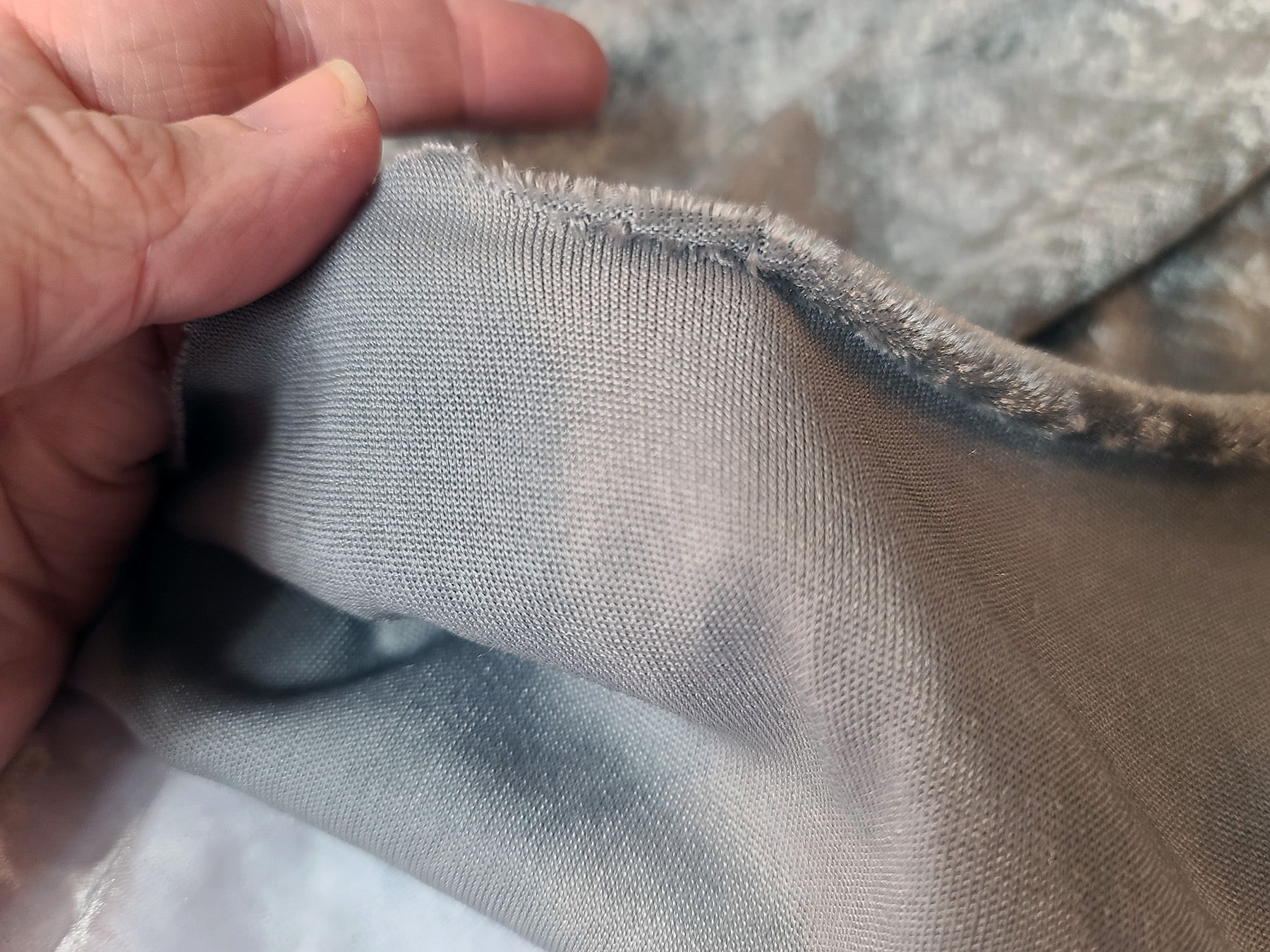
Panne Velvet
The Sheers
Power Mesh / Power Net
Power mesh (AKA Power Net) is sometimes used like illusion for the body of garments, but usually, it is used on the inside of garments as a “girdle” effect.
Tummy panels are usually made of power mesh. It can be 2 way or 4 way stretch, and is quite durable. Power mesh generally comes in black, white, and beige.
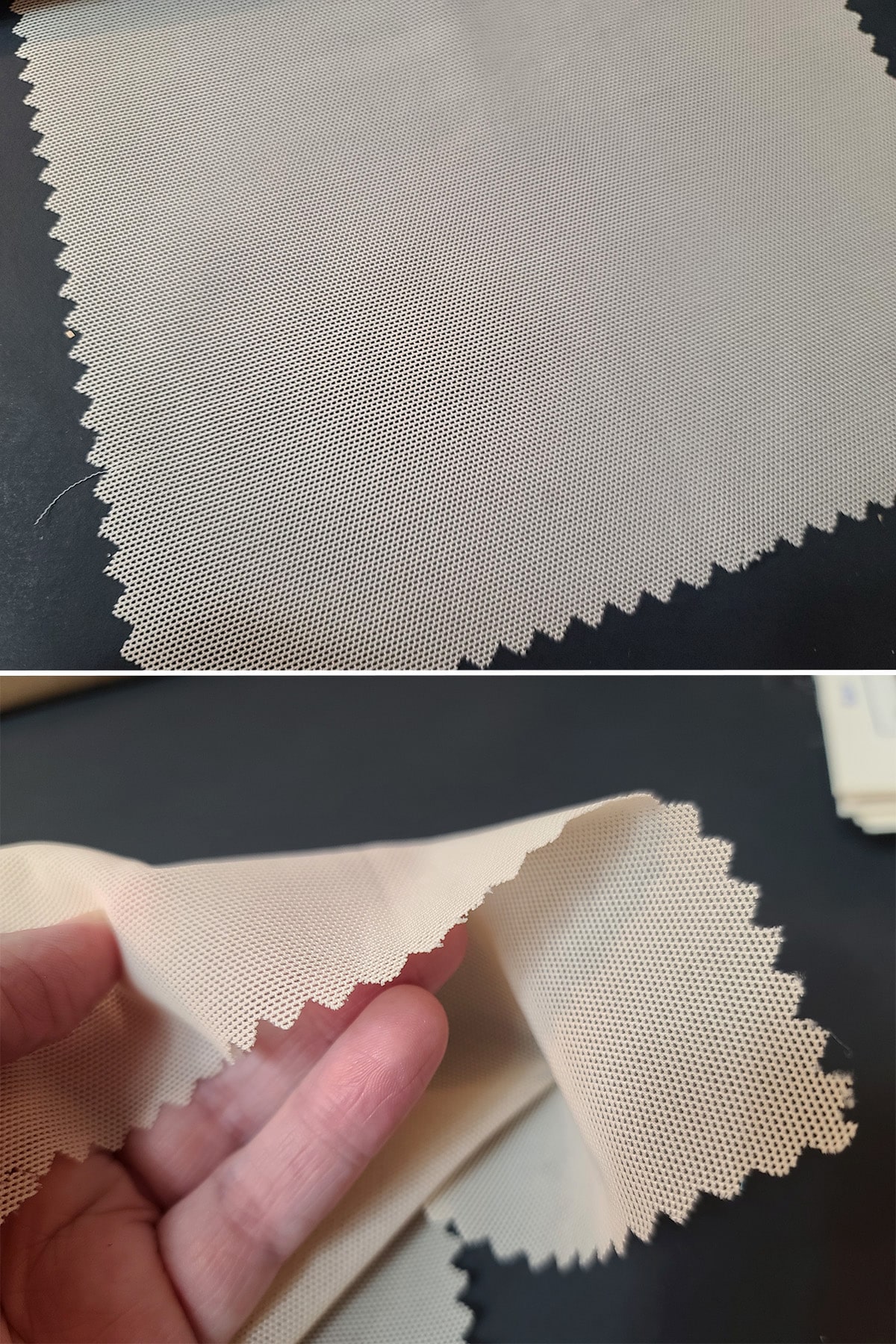
Power Mesh
Illusion (AKA “Glistenette”)
Illusion is a fabric that was much more in favour back in the 90s, but it still available these days.
It usually comes as somewhere between a 2 way and 4 way stretch - probably technically 4 way, but not a ton of stretch in one of the directions.
It comes in many colours - including various skin tones - and tends to have a tight, “solid” appearance, with a shimmery look to the right side - though either side can be used.
Illusion is used for cutouts, or to resemble skin - though the shimmer doesn’t make for very realistic “skin”.

Illusion in the foreground, stretch mesh in the background.
Stretch Mesh
Stretch mesh is sheer fabric which are available in many colours (including flesh-tones), generally as a 4 way stretch.
Stretch mesh has a matte finish, with a more open... well, MESH appearance .

Stretch Mesh
The skin colours of stretch mesh are used frequently in all kinds of spandex costuming .
As it has no sparkle to it, it makes a good alternative to illusion for a skin tone effect when a particularly invisible effect is desired.
Note: Stretch mesh differs from “Power” mesh in that it feels much less “structured”, more delicate.

Stretch Mesh (left) vs Power Net (right)
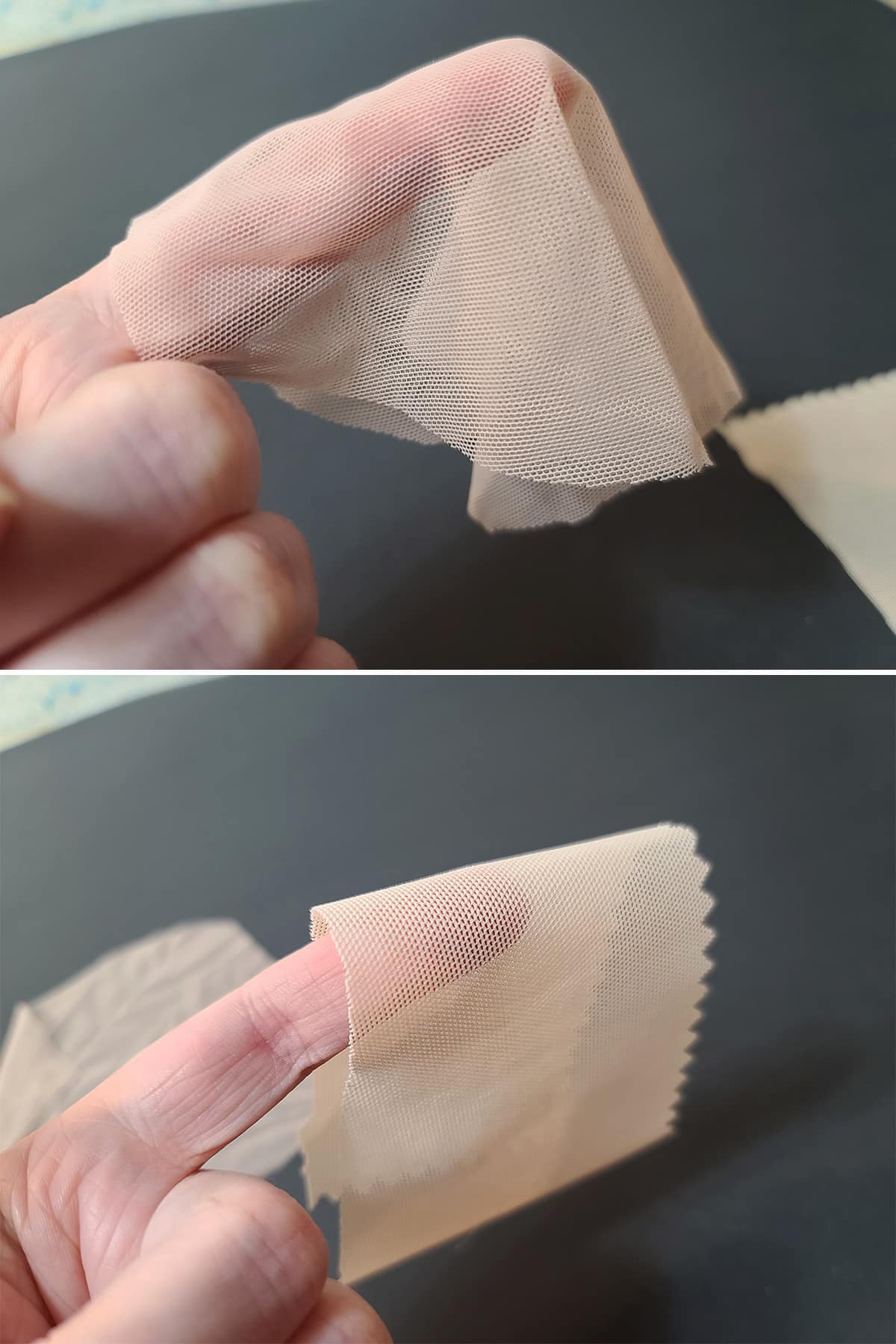
Stretch Mesh (top) vs Power Net (bottom)
Stretch mesh wouldn’t work for a girdle effect, and you would not want to use power mesh for the “skin tone” design effect that stretch mesh is usually used for.
Tinting Stretch Mesh
When a slightly darker is desired, stretch mesh is easily dyed with tea or coffee to match skin tones that fall in between the available colours.
To custom tint skin-toned stretch mesh, start with beige coloured fabric.
Decide how much darker you will need it - for “tan” colours, use tea. For darker brown colours, use coffee.
Brew a fairly strong batch of tea or coffee, place the hot liquid into a large pot.
Bring the liquid to a boil, add a small scrap of your stretch mesh fabric, and remove from heat. Allow fabric to steep in the tea for at least 20 minutes before rinsing.
If the colour is right, dye the rest of your fabric - I recommend dyeing a LOT of it, and keeping it on hand. If the colour needs to be darker, add more tea or coffee (instant works), and try again.
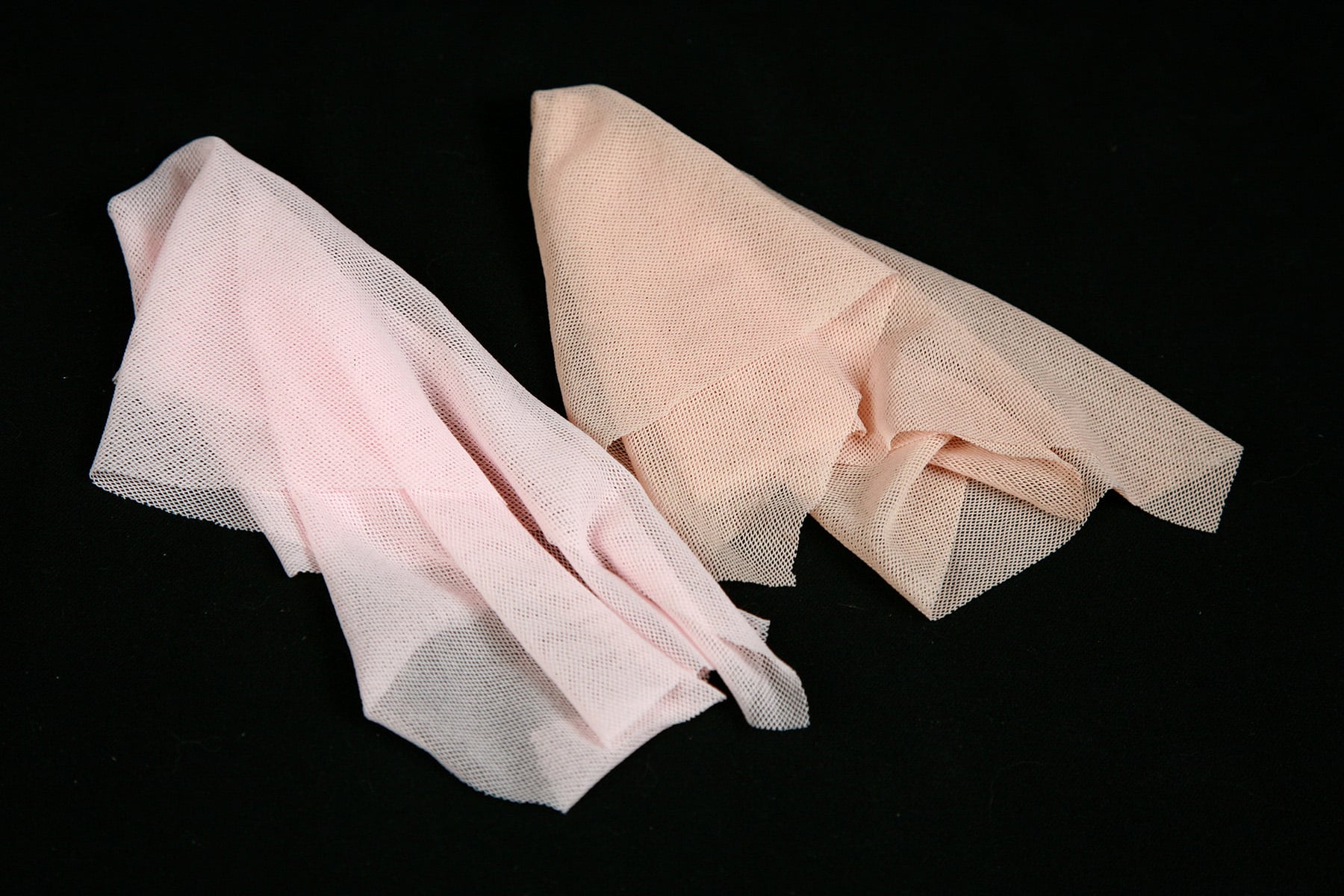
Tea dyed stretch mesh, before and after.
Stretch Lace
Stretch lace is pretty self explanatory - it’s a lace that’s made with spandex fibers included, and is stretchy as a result.
It comes in all kinds of colours and patterns - usually some variation of floral - sometimes with glitter or sequins already attached, or metallic threads incorporated.
Some versions of stretch lace are only 2 way stretch, so be sure to check for that when purchasing.

Stretch Lace
Stretch Chiffon
Stretch chiffon looks almost like a cross between illusion, and power mesh. It’s a 2 way stretch fabric, and is economically priced.
It does not fray or unravel in the same way normal chiffon does. Before stretch mesh became popular - and widely available, in a vast range of colours - it was the best option for sheer skating skirts.
Stretch chiffon is good for thinly layered skirts and pouffy sleeves, but doesn’t see a whole lot of use in spandex costuming beyond that.
Other Fabrics
Swimsuit Lining
Swimsuit lining is usually not visible when the costume is being worn - Unless used under sheer sections - but is an important part of your fabric selection, when applicable.
Generally speaking, it will be white, beige or black coloured.
As with most fabrics discussed here, there is good swimwear lining... and then, there is NOT good lining.
The thing is, the lining - in many cases - will form the foundation of your suit. A good lining will provide a good base for your applique work and/or beading. A low quality lining will not only be less durable, it can be very frustrating to work with.
Distinguishing between the two can be tricky, especially when dealing solely with text!
Good swimwear lining feels durable and substantial, with a good amount of 4 way stretch. When stretched, it will not “run”.
Low quality swimwear lining feels more flimsy, can run, and tends to only have 2 way stretch to it.

Swimsuit Lining
Ponte De Roma
Ponte De Roma is a thick, soft, matte-ish finish double-knit jersey fabric made from rayon, nylon, and spandex.
It has OK stretch in one direction, and I mainly use it for making boys / mens fake Blue Skys pants, as well as matte finish figure skating pants in general.
Sometimes you can find it in a denim print, which is fun for making skating pants that look like jeans:

Denim Look Ponte De Roma
Slinky
Slinky is a stretchy fabric that’s... well, slinky. I don’t tend to use it as a foundation/structural fabric, but it makes nice dresses and skirts for dance.
You mainly see it used for fashion and dance, not so much for skating, gymnastics, etc. It can come with or without glitter, and in a variety of colours.
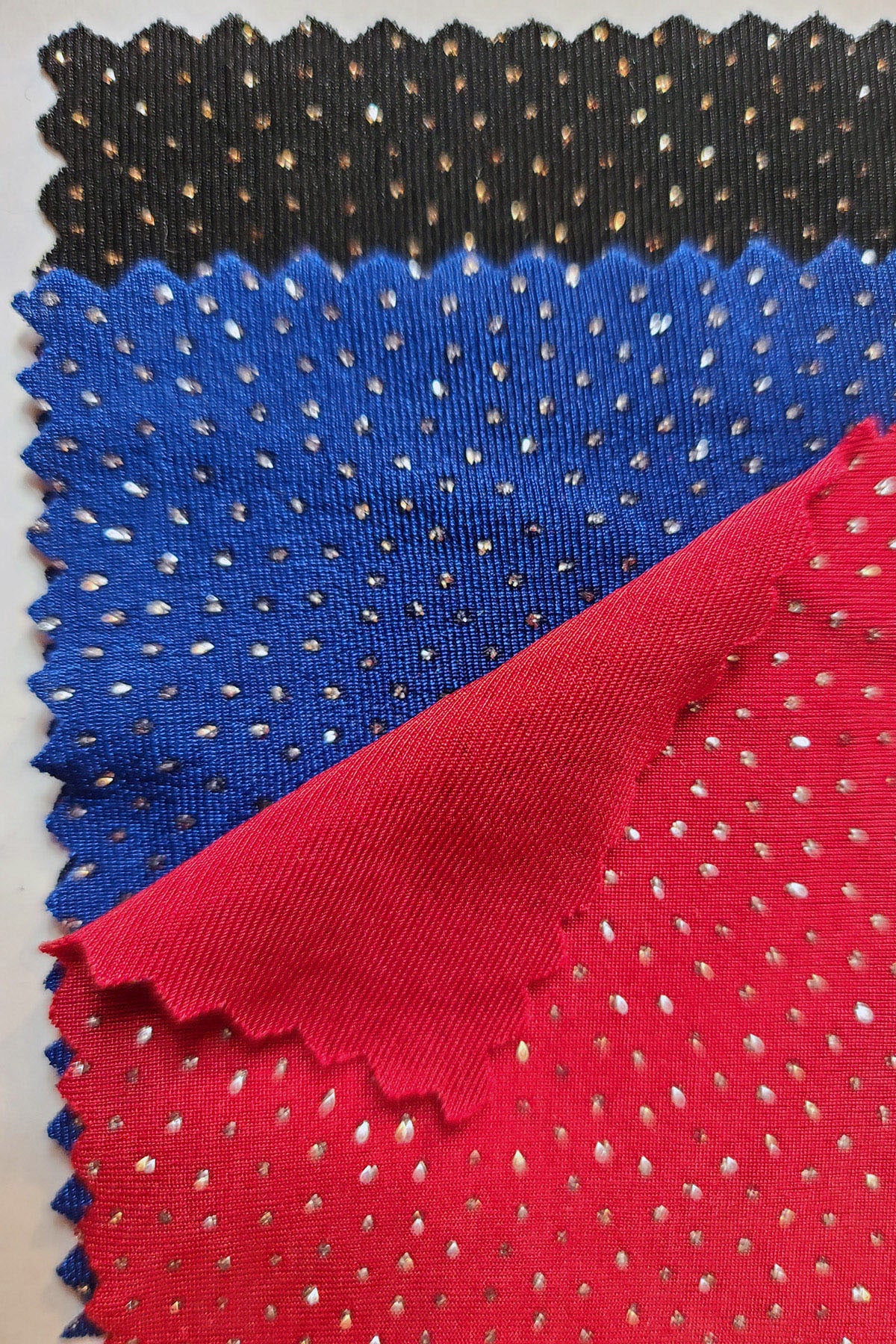
Slinky
Stretch PVC
(I stopped using this a while back - it annoys me! - so don’t actually have any photos! I’ll get some and add them at some point!)
PVC is a popular fabric for use in clubwear and fetishwear, and has been seeing a lot of popularity for use in cosplay.
The shiny “patent leather” finish to it works well for things like Catwoman costumes, “sexy” versions of popular superhero costumes, and more.
PVC comes in a few main types, only one of which is really appropriate for use in *stretch* costuming:
- Non stretchy: This is a (usually) heavy duty woven fabric with PVC coating that can be used for things like belts, utility belt features, purses, etc. Don’t use this for anything in this blog, aside from maybe some accessories!
- 2-way stretch: This can be used for things that only need to stretch 1 way, and don’t need a ton of stretch. Think “Matrix” coats, some pants (NOT tights!), bras, etc .
- 4-way stretch: This is PVC coated 4 way stretch Lycra®, and has the greatest degree of stretch. If you’re looking to use PVC as a “body” fabric, or anything tight... this is what you want.
Sewing with Stretch PVC
There are a few things to keep in mind when sewing with PVC, that aren't really covered in the main sewing section of this blog.
Some tips:
- Along the edge (selvage) of the fabric, the vinyl tends to pull up from the fabric a bit, and not be as solidly fused down. Don't let this worry you, just don't cut pieces near that area.
- Unlike most fabrics - spandex included - PVC doesn't "heal". Any hole you make in it will remain in it, and can be very visible.
Additionally, it's a stress point that can eventually perforate the PVC coating. For this reason, I don't recommend using pins on the fabric, at ALL.
Also, try to be as accurate as possible in cutting and sewing your pattern - you're not going to want to rip out seams and start over.
- Use a very sharp, stretch needle... as thin as you can find. Don't use ballpoint or universal needles.
My thread recommendations in the work well for PVC as well as spandex: Polyester, not cotton.
- Another thought along the lines of perforation ... don't use a really short stitch length.
Use a medium to long straight stitch, finishing the seam off with a zig zag or serger. A very short stitch will have many holes placed closely together - this can cause the PVC coating to perforate and peel up from the seam. Not good!
Also: Don’t stretch the fabric as much as you would spandex.

Hologram Spandex
Spandex FAQ
How to Sew Stretch Fabric
Stretch fabrics can be sewn with a basic sewing machine, and/or a serger. See my post How to Sew Spandex With or Without a Serger for all of the details!
How to Wash Spandex Fabric
In short? Carefully and with low to no heat. For full details, see my post Proper Care of Spandex Costumes.
Can You Wear Spandex in the Pool?
Depends on the actual fabric, but generally yes.
You’ll want a nylon spandex, ideally one that’s been labelled chlorine resistant, ideally. If not actually chlorine resistant, just make sure to thoroughly rinse it immediately after use.
Can you Bleach Polyester Spandex?
Technically... sort of.
Bleach WILL lighten spandex, but not necessarily in a uniform way... and - more importantly - it damages the fibres. The thing I mentioned earlier about rinsing chlorine out?
Bleach eats spandex. No real point in trying to lighten fabric you want to work with, only for it to fall apart prematurely!
Can You Be Allergic to Spandex?
You can definitely be allergic to spandex, whether the fiber itself, OR the preparation and/or circumstances.
Aside from actually having an allergy to Elastane / Spandex / Lycra®, etc - or any of the other fibers they can be blended with, you can ALSO react to the chemicals used to dye them, etc.
Spandex is pretty far from anything resembling natural, and many chemicals are used in their production. This is part of why people will wash spandex before cutting it - it’s not a matter of pre-shrinking, it’s about getting the crap out.
Beyond that, spandex can be pick up allergens in production, in warehouses, in transit, and in retail settings. Honestly, a lot of spandex is pretty dirty by the time it makes it to the consumer.
Even beyond all of THAT, the use of spandex lends itself to allergic-like reactions, even without an actual allergy. As it doesn’t breathe well, it can trap sweat and cause rashes, contact dermatitis, hives, etc.
Then there’s the matter of associated items.
I’m often asked “Does spandex contain latex?”, and the answer is no. Spandex does NOT contain latex itself.
That said, elastic can - and often does - contain latex.
Very few spandex garments are made without elastic, so if a latex allergy is a concern, you’ll want to be careful when purchasing your elastic - and potentially other notions.
Is Spandex Vegan?
Yes, spandex is vegan. There is basically nothing natural involved with the production of Lycra®, after all!
How to Keep Spandex from Rolling Up
There are two main reasons that spandex will roll up: Fit and finish.
Fit: Spandex garments that are either too big or two small will be more prone to rolling up.
Make sure you’re making - or buying - appropriately sized garments, especially when it comes to shorts and fitted tops.
Finish: Unlined shorts and tops are more prone to rolling up than lined ones. Fitted garments with a basic sewn hem are more likely to roll up than fitted garments with an elastic hem.
If you’re having trouble with a garment rolling up - and it fits well aside from that - try adding an elastic.
If you’re STILL having trouble with it, try having the elastic bare against the skin, rather than enclosed in the hem. There are types of elastic that are specifically meant to be “grippy” for this use.

Printed Nylon Lycra®
Getting Started with Spandex Costuming
Looking for more posts on the basics of spandex costuming?
Colour Theory for Spandex Costuming
How to Measure for Spandex Costuming
Spandex Costuming Tools & Supplies
Spandex Costuming Design Principles
Basic Pattern Alterations
How to Cut Spandex
How to Sew Spandex With or Without a Serger
... and be sure to check out our Table of Contents for an organized listing of all of our posts.
Share the Love!
Be sure to take some pics of your handiwork! If you post it to Bluesky, be sure to tag us - @SpandexSimplified.
Also, be sure to follow me on Pinterest, and subscribe to my Youtube Channel, so you never miss out on any of my nonsense. Well, the published nonsense, anyway!
Finally: If you loved this tutorial - or have any questions about it - please leave a comment below! I'll do my best to answer any questions you may have!

Hologram Spandex





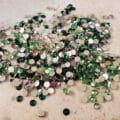
What an awesome article. Thank you so much for sharing your knowledge!!!
Sure - click the "Resources" link on the top menu!